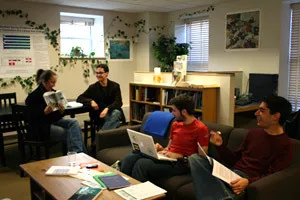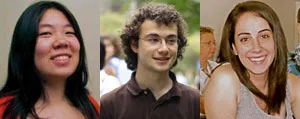Need Help? Consult a WA, WAM, SPA, or SAM. See a Wizard, Jedi, Pi-rate, or Ninja.
Peer-mentoring programs offer students help across disciplines

Students can drop in at the Writing Center in Trotter Hall for consultation about written assignments.
Whether they are uncertain about articulating an idea for an English paper or tackling a difficult proof in math, all students discover early on in their Swarthmore sojourns that reaching out for help is a necessary component of their four years on campus.
Fortunately, with the help of the "alphabet soup" of peer mentoring programs, students never need to go it alone.
"I think there is a difference between tutoring and peer mentoring. Tutoring implies a narrow focus on particular knowledge or skills. Peer mentoring, on the other hand, implies skill acquisition as well as everything else that goes into learning," says Diane Anderson, associate dean for academic affairs. "The ‘everything else' might include study tips, rhetorical strategies, implicit procedural information, as well as personal experiences."
"To WA" is a verb
One of the most popular resources is the Writing Associates (WA) Program, where students who have been nominated and carefully chosen for the position work closely with their peers to help the latter improve their writing skills.
"Last year, we had 200 nominations [for WAs] with 67 people who applied. We select anywhere from 20 to 30, so now we have 60 WAs on staff," Jill Gladstein, WA director, says. "When WAs are attached to a course, they meet with the professor to discuss expectations of the assignments. Then, after reading their papers, the WAs meet in conferences with students in order to develop a plan for revisions."
Most students work with a WA in some capacity during their Swarthmore careers. "WAs help students in every stage of the writing process, in any discipline," WA Naudia Williams '14, says. "We offer constructive feedback to students without the intimidating ‘professor's pen'. Students come to us with the assurance that we will be attentive to their unique needs as writers at Swarthmore."
In fact, WAs are so much a part of the Swarthmore culture that they have lent new language to the student lexicon. "To WA" is a verb, and WAs engage in "WA-ing" when mentoring fellow students—who in turn are called "WA-ees."
WAM-ing and SPA-ing are part of the lexicon, too. The Writing Associate Mentor (WAM) Program "offers semester-long or year-long mentoring on a weekly basis for regular course writing, theses, or grant applications." Moreover, the recent addition of the Speaking Associates (SPA) Program, which helps students create better oral presentations, allows an ever-wider range of needs to be met.
"The individualized support we offer the campus is critical in allowing our program to support Swarthmore's diverse student body," Dante Fuoco '12, WAM coordinator, says.

Pi-Rate Christina Duron '12 (right) is a mathematics major with a minor in computer science from Claremont, CA. "I enjoy being a pi-rate because I understand how difficult mathematics can be at times and I love to help students understand its technicalities." Wizard Ozan "Ozy" Erturk '12 (middle) from Canakkale,Turkey, is an engineering major with a concentration in electrical/electronics concentration and a chemistry minor. "I love teaching; I am very intrigued by how people learn differently and every time I try to explain something different I learn something, too." "I was accepted to Hogwarts School of Witchcraft and Wizardry, but I told Dumbledore that I'd rather be a wizard at Swarthmore," says Wizard Jillian Ma '14 (left) from Rose Valley, PA, a neuroscience major who plans to minor in engineering and education. "I love teaching and meeting other students."
No Shortage of Help
The WA, WAM, and SPA programs are only three of many aimed at helping students. Student Academic Mentors (SAMs) are assigned to certain residence halls to help students, especially those in their first year, who need advice on general academic questions such as study tips or course choices.
A group of student Wizards holds five help sessions a week for engineering, physics, and math students to provide them with "alternative insights, examples, strengths and styles" in learning the curriculum, says Ann Ruether, academic resources coordinator for the engineering department. As for the name, Ruether says, "the original Wizards likely drew inspiration … from the Harry Potter books that were popular at the time of the program's inception."
Another student group, the Jedis, takes its name from Star Wars and reflects a zeal for science, offering assistance to physics and astronomy students. Like the Wizards Program, Ruether says, they "serve an important role for the courses and through time have become an integral part of the learning experience for numerous students."
Pi-rates help students in Math 15, 25, and 27—all part of the calculus and linear algebra sequence of courses offered by the department of mathematics and statistics. Approximately two-thirds of enrolled students attend at least one Pi-rate session, and about half of enrolled students attend regularly. Most attendees seek homework help.
Ninjas assist students taking Computer Science (CS) 21, Introduction to Computer Science, and CS35, Data Structures and Algorithms. About one-third of CS21 students and about 88 percent of CS35 students have attended at least once this semester. For the most part, Ninjas assist students with weekly lab assignments that involve designing computer programs. However, the mentoring is not only rewarding for those receiving help.
"That moment when the program runs with no errors is quite a rush," CS21 Ninja Leah Foster '14, said. "But it's the best when I'm working with someone and they get something they haven't before. They go ‘Oh!' and I can actually see the understanding."
At a place like Swarthmore, known for its academic rigor, the need for occasional academic support cannot be understated. However, with the help of the many valuable peer-mentoring programs, no student need ever feel hesitant to seek help.



